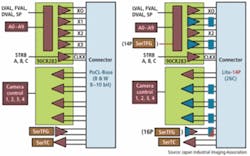IMAGE TRANSFER - Camera Link gets a ‘Lite’ interface
“Same great interface but a less bulky connector” would be the slogan for the latest proposed Camera Link standard developed by the Japan Industrial Imaging Association (JIIA; Tokyo, Japan; www.jiia.org). The standard has been conceived by Shigeo Oka, chairman of the JIIA and Senior Fellow in the Machine Vision and Medical Imaging Division of Toshiba Teli (Tokyo, Japan; www.toshiba-teli.co.jp), and Fumio Nagumo of CIS (Seattle, WA, USA; www.cis-americas.com). Known as Power over Camera Link Lite (PoCL-Lite), it was previewed at The Vision Show 2009 (Phoenix, AZ, USA) in April 2009 and is expected to be ratified by the Automated Imaging Association (Ann Arbor, MI, USA; www.machinevisiononline.org) at the June 2009 Robots, Vision & Motion Control Show (Rosemont, IL, USA).
To allow the manufacture of smaller and lower-cost digital cameras with smaller connectors while retaining the same PoCL features, the new standard only represents a small departure from the original Camera Link standard.
In the original 26-pin Camera Link design, pins 1, 13, 14, and 26 were assigned as ground. To maintain backward compatibility with this connector, the PoCL reassigned pins 1 and 26 as power lines that deliver up to 333 mA at 12 V or 400 mA at the lowest allowable 10 V. In essence, PoCL-Lite redefines the PoCL standard using just 14 pins, two of which are used for power, two for shielding, and five pairs of wires to transmit Camera Link data and camera signals (see figure).
Because of this, 12 pins of the original PoCL connector are left unused, allowing a smaller PoCL-Lite connector to be used to interface the camera to a frame grabber. Within the five pairs of data signals that are used in the PoCL-Lite standard, one pair is dedicated to camera control, one pair to send serial data commands to the camera, one pair as a system clock, and the remaining two pairs devoted to transferring data between the camera and the frame grabber.
In PoCL-Base, the data from four differential pairs are multiplexed into two data lines (x0 and x2), and another differential pair is used for serial communications to the frame grabber (SerTFG). PoCL-Lite, however, uses only two differential pairs to transmit data valid, frame valid, and line valid information as well as SerTFG and image data on one pair (x2) and image data on the second line (x0).
As can be seen, this results in a 10-bit image data transfer over two differential line pairs. Using transceivers clocked at 85 MHz, this results in a maximum data transfer rate of approximately 106 Mbytes/s. Just as Basler Vision Components (Ahrensburg, Germany; www.baslerweb.com) redefined the Camera Link standard data valid (DVAL) pins as a video data-transfer pin to support its A504 series of high-speed cameras, the PoCL-Base standard is not electrically compatible with PoCL-Lite.
Thus, to support this standard, frame grabber vendors will need to reprogram the FPGA interface available on most Camera Link frame grabbers. Cable suppliers will also need to develop 14-pin cables that can be used to interface PoCL-Lite standard cameras to to-be-announced PoCL-Lite frame grabbers and legacy Camera Link frame grabbers that use the MDR-26 connector.
Luckily, cable vendors are aware of this situation and 3M (Austin, TX, USA; www.3m.com/machinevision) has already developed a PoCL-Lite-to-PoCL-Lite cable and is considering a PoCL-Lite-to-MDR-26 cable. To demonstrate the effectiveness of this interface, CIS also demonstrated a prototype PoCL-Lite CMOS camera at The Vision Show. Due to the current unavailability of any PoCL-Lite frame grabbers, a VGA camera running at 60 frames/s was shown interfaced to an iPORT PT1000-CL Camera Link-to-Gigabit Ethernet interface port from Pleora Technologies (Kanata, ON, Canada; www.pleora.com) and displayed on a portable PC.
Whether the new PoCL-Lite standard will gain momentum after ratification by the AIA remains to be seen. According to Chris Hogarth, interconnect business development manager with 3M, the original PoCL standard, although popular in Japan, is only now starting to gain a following in North America, driven by a need to reduce camera size in higher-performance applications. Going forward, to further expand this capability into other (traditionally analog) performance tiers where space is at a premium and a relatively fast digital upgrade is required, the emerging PoCL-Lite standard will meet the requirements.

